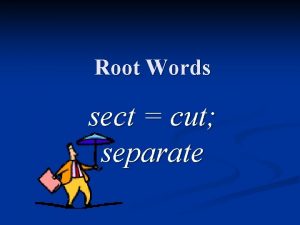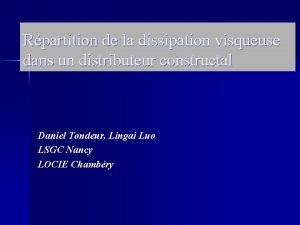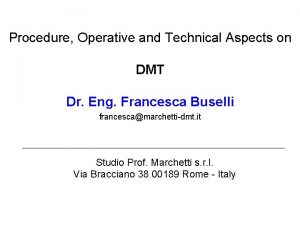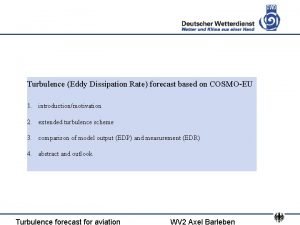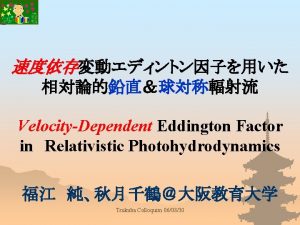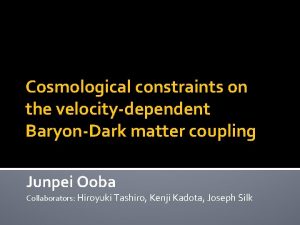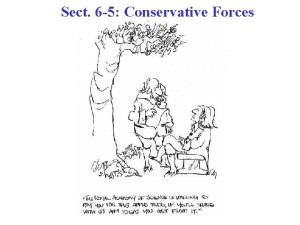Sect 1 5 VelocityDependent Potentials the Dissipation Function







![• Rayleigh’s Dissipation Function ₣ ₣ (½)∑i[kx(vix)2 + ky(viy)2 + kz(viz)2] • Frictional • Rayleigh’s Dissipation Function ₣ ₣ (½)∑i[kx(vix)2 + ky(viy)2 + kz(viz)2] • Frictional](https://slidetodoc.com/presentation_image_h/ae0c9a2e0db629cf5e30ead9c9dabe46/image-8.jpg)
- Slides: 8


Sect. 1. 5: Velocity-Dependent Potentials & the Dissipation Function • Non-conservative forces? It’s still possible, in a Special Case, to use Lagrange’s Eqtns unchanged, provided a Generalized or Velocity-Dependent Potential U = U(qj, qj) exists, where the generalized forces Qj are obtained as: Qj - ( U/ qj) + (d/dt)[( U/ qj)] • The Lagrangian is now: L T - U & Lagrange’s Eqtns are still: (d/dt)[( L/ qj)] - ( L/ qj) = 0 (j = 1, 2, 3, … n) • A very important application: Electromagnetic forces on moving charges.

Sect. 1. 5: Electromagnetic Force Problem • Particle, mass m, charge q moving with velocity v in combined electric (E) & magnetic (B) fields. • Lorentz Force (SI units!): F = q[E + (v B)] (1) • E&M results that you should know! E = E(x, y, z, t) & B = B(x, y, z, t) are derivable from a scalar potential = (x, y, z, t) and a vector potential A = A(x, y, z, t) as: E - - ( A/ t) B A (2) (3)

• Can obtain the Lorentz Force (1) from the velocity dependent potential: U q - q. A v F = - U – Proof: Exercise for student! Use (1), (2), (3) together. • Lagrangian is: L T - U = (½)mv 2 - q + q. A v • Use Cartesian coords. Lagrange Eqtn for coord x (noting v 2 = (x)2 + (y)2 + (z)2 & v = x i + y j + z k) (d/dt)[( L/ x)] - ( L/ x) = 0 mx = q[x( Ax/ x) + y( Ay/ x) + z( Az/ x)] - q[( / x) + (d. Ax/dt)] Note that: (d. Ax/dt) = v Ax + ( Ax/ t) (a)

mx = - q( / x) - q( Ax/ t) + q[y{( Ay/ x) - ( Ax/ y)} + z{( Az/ x)- ( Ax/ z)}] • Using (2) & (3) this becomes: mx = q[Ex + y. Bz -z. By] Or: mx = q[Ex + (v B)x] = Fx (Proven!) • If some forces in the problem are conservative & some are not: Have potential V for conservative ones & thus have the Lagrangian L T - V for these. For non-conservative ones, still have generalized forces: Qj ∑i. Fi ( ri/ qj)

Non-Conservative Forces • L T - V for conservative forces. • Generalized forces: Qj ∑i. Fi ( ri/ qj) for non-conservative forces. • Follow derivation of Lagrange Eqtns & get: (d/dt)[( L/ qj)] - ( L/ qj) = Qj (j = 1, 2, 3, . . n) • Friction: A common non-conservative force. • Friction (or air resistance): A common model: Components are proportional to some power of v (often the 1 st power): Ffx = -kxvx (kx = const)

Frictional Forces • Model for Friction (or air resistance): Ffx = -kxvx • Can Include such forces in Lagrangian formalism by introducing Rayleigh’s Dissipation Function ₣ ₣ (½)∑i[kx(vix)2 + ky(viy)2 + kz(viz)2] • Obtain components of the frictional force by: Ffxi - ( ₣/ vix), etc. Or, Ff = - v₣ • Physical Interpretation of ₣ : Work done by system against friction: d. Wf = - Ff dr = - Ff v dt = -[kx(vix)2 + ky(viy)2 + kz(viz)2] dt = -2₣ dt Rate of energy dissipation due to friction: (d. Wf /dt) = -2₣
![Rayleighs Dissipation Function ½ikxvix2 kyviy2 kzviz2 Frictional • Rayleigh’s Dissipation Function ₣ ₣ (½)∑i[kx(vix)2 + ky(viy)2 + kz(viz)2] • Frictional](https://slidetodoc.com/presentation_image_h/ae0c9a2e0db629cf5e30ead9c9dabe46/image-8.jpg)
• Rayleigh’s Dissipation Function ₣ ₣ (½)∑i[kx(vix)2 + ky(viy)2 + kz(viz)2] • Frictional force: Ffi = - vi ₣ • Corresponding generalized force: Qj ∑i. Ffi ( ri/ qj) = - ∑i vi₣ ( ri/ qj) Note that: ( ri/ qj) = ( ri/ qj) Qj = - ∑i vi₣ ( ri/ qj) = - ( ₣/ qj) • Lagrange’s Eqtns, with frictional (dissipative) forces: (d/dt)[( L/ qj)] - ( L/ qj) = Qj Or (d/dt)[( L/ qj)] - ( L/ qj) + ( ₣/ qj) = 0 (j = 1, 2, 3, . . n)
